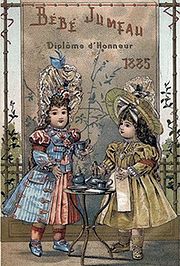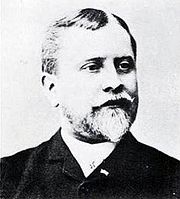
Pierre-François Jumeau
Encyclopedia

Paris
Paris is the capital and largest city in France, situated on the river Seine, in northern France, at the heart of the Île-de-France region...
), was the founder in the 1840s of the French firm Jumeau, that produced bisque doll
Bisque doll
A bisque doll or porcelain doll is a doll made partially or wholly out of bisque porcelain. Bisque dolls are characterized by their realistic, skin-like matte finish. They had their peak of popularity between 1860 and 1900 with French and German dolls. Bisque dolls are collectible, and antique...
s and china doll
China doll
A china doll is a doll made partially or wholly out of glazed porcelain. The name comes from china being used to refer to the material porcelain...
s. His second son Emile-Louis Jumeau, born in 1843, began assuming management of the company in the 1870s.
Pierre-François Jumeau
Pierre-François's family owned a fabric shop in RémalardRémalard
Rémalard is a commune in the Orne department in north-western France.-References:*...
, south-west of Paris, in 1837. On a business trip to Paris he met and eventually married in January 1841 the niece of one of the few dollmakers in France, Lucius-Junius Herissey. Jumeau gained invaluable experience by joining the Herissey business, which had good prospects due to the improved French economy and the growth of international markets.
In 1841 Jumeau was in partnership with Louis-Desire Belton, but started his own business a few years later after the death of his wife in 1844. By 1848 Jumeau had become the foremost doll manufacturer, had won a bronze medal at the 1849 Paris Exposition and was invited in 1851 to take part in the Crystal Palace Exhibition in London where he won a First Place Medal, the dresses being singled out for praise. The Jumeau dolls were widely acclaimed, winning numerous awards at international exhibitions. The first dolls were papier-mâché
Papier-mâché
Papier-mâché , alternatively, paper-mache, is a composite material consisting of paper pieces or pulp, sometimes reinforced with textiles, bound with an adhesive, such as glue, starch, or wallpaper paste....
and were unmarked, causing present-day attribution problems, so that only a small number of Jumeau dolls made before the 1870s can be identified with certainty. In the 1850s glazed porcelain dolls
China doll
A china doll is a doll made partially or wholly out of glazed porcelain. The name comes from china being used to refer to the material porcelain...
had been added to the firm's inventory, but the bisque doll
Bisque doll
A bisque doll or porcelain doll is a doll made partially or wholly out of bisque porcelain. Bisque dolls are characterized by their realistic, skin-like matte finish. They had their peak of popularity between 1860 and 1900 with French and German dolls. Bisque dolls are collectible, and antique...
s were its greatest success, and the company acquired a reputation for the beauty, grace, elegance and quality of its products.
In 1872, Pierre-François, unhappy with the dolls' heads from Germany, started a porcelain factory at Montreuil
Montreuil, Seine-Saint-Denis
Montreuil is a commune in the eastern suburbs of Paris, France. It is located from the center of Paris. It is the third most populous suburb of Paris...
to produce his own heads and began supplying other dollmakers.
From his marriage to Adèle Amélie Aumoitte, Pierre-François produced two children, Georges Eugène (1841–1873) and Emile (born 18 April 1843). Adèle died on 16 May 1843 following Emile's birth. In 1854, Pierre-François married Adélaïde Elisa Mayo who died in 1888.
Emile-Louis Jumeau

Longny-au-Perche
Longny-au-Perche is a commune in the Orne department in north-western France.-Heraldry:-References:*...
in 1866, began assuming management of the company and in 1877 he introduced the Bébé Incassable, with a head made by Jumeau, the face of a young girl and a fully articulated composition
Composition doll
A composition doll is a doll made partially or wholly out of composition, a composite material composed of sawdust, glue, and other materials such as cornstarch, resin and wood flour. Composition dolls were marketed as unbreakable and hailed as an improvement in doll making from the fragile bisque...
body. Jumeau's dolls were fashionably dressed in the styles popular at the time, and often had shapely mature figures. As with modern Barbie
Barbie
Barbie is a fashion doll manufactured by the American toy-company Mattel, Inc. and launched in March 1959. American businesswoman Ruth Handler is credited with the creation of the doll using a German doll called Bild Lilli as her inspiration....
dolls, large ranges of clothing styles and accessories were made available. In 1878 the company was awarded a gold medal at the Paris Exhibition
Exposition Universelle (1878)
The third Paris World's Fair, called an Exposition Universelle in French, was held from 1 May through to 10 November 1878. It celebrated the recovery of France after the 1870 Franco-Prussian War.-Construction:...
, an honour which was proudly advertised on all their products. Further awards followed at the International Exhibitions in Sydney
Garden Palace
thumb|300px|Sydney's Garden Palace; an architectural drawing from the 1870s.The Garden Palace was a large purpose-built exhibition building constructed to house the Sydney International Exhibition ...
in 1879 and Melbourne
Melbourne International Exhibition (1880)
The Melbourne International Exhibition was held from 1 October 1880 until 30 April 1881. It was the second international exhibition to be held in Australia , the first being held the previous year in Sydney...
in 1880. In 1885, at the Antwerp Exhibition, Jumeau's dolls won the Diplôme d’Honneur, an award subsequently commemorated by being stamped on every doll made. The golden age of the company spanned the period from the late 1870s to the late 1890s when the company employed over 200 workers with an annual output of 100 000 dolls.
Emile-Louis' expansion into the international market pushed sales to new heights. In 1879 the Emperor's sculptor, Albert-Ernest Carrier-Belleuse
Albert-Ernest Carrier-Belleuse
Albert-Ernest Carrier-Belleuse was a French sculptor and painter.- Life :Carrier-Belleuse was a student of David d'Angers and briefly at the École des Beaux-Arts...
was commissioned by Jumeau to fashion an epicene
Epicene
Epicene is an adjective for loss of gender distinction, often specific loss of masculinity. It includes:* effeminacy — a man with characteristics that are traditionally feminine...
head, to be used as that of either boy or girl. Carrier-Belleuse is reputed to have used a portrait of King Henry of Navarra
Henry IV of France
Henry IV , Henri-Quatre, was King of France from 1589 to 1610 and King of Navarre from 1572 to 1610. He was the first monarch of the Bourbon branch of the Capetian dynasty in France....
at age four as model and the design became known as Jumeau Triste. Emile-Louis becomes a Knight of the Légion d’Honneur in 1889. Henri Lioret, a French watchmaker and pioneer in the manufacture of talking machines, helps the firm develop Bébé Phonographe, the talking doll in 1894.
The plant at Montreuil
Montreuil, Seine-Saint-Denis
Montreuil is a commune in the eastern suburbs of Paris, France. It is located from the center of Paris. It is the third most populous suburb of Paris...
outside Paris
Paris
Paris is the capital and largest city in France, situated on the river Seine, in northern France, at the heart of the Île-de-France region...
put together the finely featured heads with glass eyes, composition bodies (originally wood or kid-leather) with jointed limbs and articulated fingers. Here they also produced hats, gloves, shoes, muffs, stockings and underwear for the dolls. Emil-Louis' wife, Ernestine Jumeau, working from the Rue Pastourelle, decided on designs and fabrics that would complete the elaborate costumes that made the Jumeau firm's dolls a household word.
French dollmakers were eventually forced to close down by cheaper German dolls appearing on the market in the 1890s. As a final attempt at economic survival, they joined forces as the Société Française de Fabrication de Bébés et Jouets
Société Française de Fabrication de Bébés et Jouets
The Société Française de Fabrication de Bébés et Jouets was a large doll making consortium founded in France by the union of a number of major French doll companies including Jumeau and Bru and the Franco-German doll company Fleischmann and Bloedel in 1899. The company went out of business in the...
(SFBJ). When the Jumeau company finally wound up its business in 1899, the remaining stock was taken over by the SFBJ. This included large numbers of bébés, heads, bodies, costumes and other components, making attribution to Jumeau or SFBJ extremely difficult of dolls turned out during the transition period.
Jumeau dolls are usually marked with a simple number, although the body may also be stamped. The Tete Jumeau is marked 'Depose Tete Jumeau' behind the head.
The Jumeau models included Deposes, E. J. Bébés, Triste, Portrait Bébé, Poupée de Modes, Bébé Phonographe and Tete Jumeau Bébés. Some of the earlier models are much sought-after and reproduction of Jumeau dolls supports a thriving industry.

